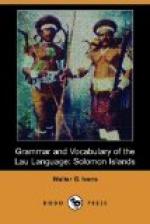The termination a is suffixed to substantives and verbs: rodo night, rorodoa dark, darkness, cloud; bulu to be black, bubulua black.
La is suffixed to substantives and verbs: mwai a bag, mwaila rich, kobu to be fat, kobukobula fat, whole, big; tagalo to be wandering, tagalola matted, thick, of forest.
b. Adjectival prefixes are a, ma, tata, m. These are all prefixed to verbs.
The a is prefixed to verbs to form participles: luga to loose, aluga loose; la to lift up, alaa upwards, up.
Ma denotes condition: lingi to pour, malingi spilled, ngi to divide, mangisingisi broken, divided, matala only, merely; tefe mwela matala an only child.
Tata denotes spontaneity: tatagwelu headlong.
M as a prefix appears to be used in the word moi broken, (Sa’a ’o’i to break, ma’o’i broken).
3. Comparison: Degrees of comparison are shown by the use of prepositions or adverbs, or by a simple positive statement. The prepositions used are fasi from, tasa beyond, in excess. The suffixed pronoun is used with fasi, but the possessive is used with tasa: na boso nia baita fasia na asufe a pig is larger than a rat; gera baita tasa agera these are much larger than those.
The adverbs employed are gele little, somewhat, asia very, too much: nia baita asia it is very (too) large.
A positive statement carries comparison by implication: doo ne nia baita that is biggest, sai ai ne ni diena, sai ai nena ni taa na this is good, that is bad; i.e., this is better than that.
VERBS.
Almost any word may be used as a verb by prefixing the verbal particles, but some words are naturally verbs as being the names of actions and not of things. There are also verbs which have special forms as such by means of a prefix or termination. Verbal particles precede the verb; they have a temporal force.
1. The verbal particles are ka, ko. The particles are written apart from the verb, but the speakers like to join them to the governing pronouns of the first and second persons singular, gu, o.
Ka is used both of present and of future time: nia ka bae uri he speaks thus, ka urina if that be so, tasi doo taa gera ka odea what will they do? lelea ka rodo go till nightfall; the illatives fi, fe, may be added.
Ko is used only with the personal pronoun, second singular o, and may express either present or future time: the illative may be added.
The preposition fuana to him, to it, in order that, is used as a subjunctive or optative.




